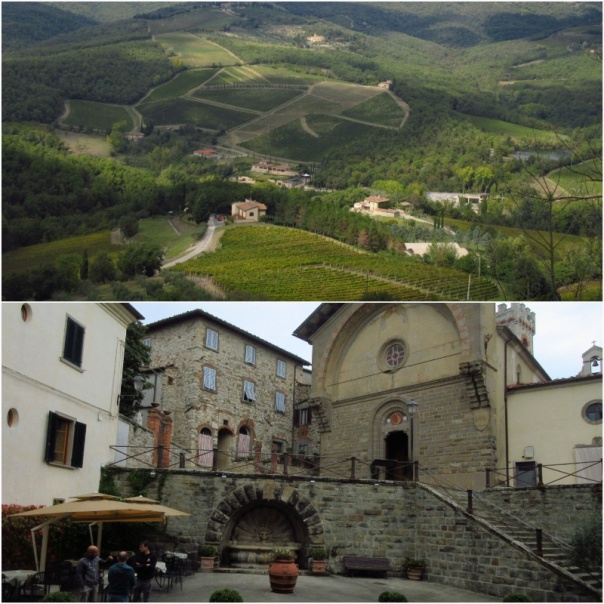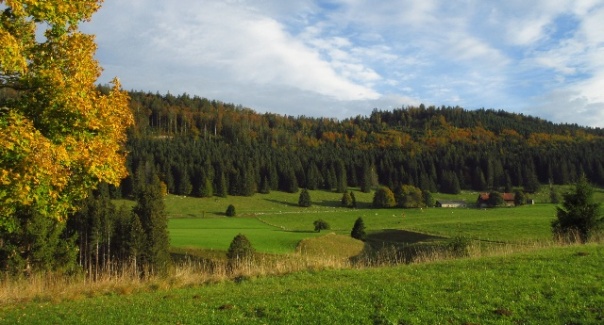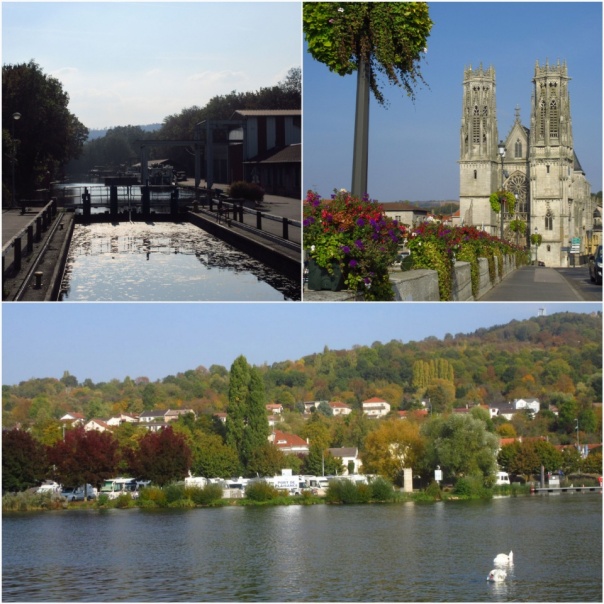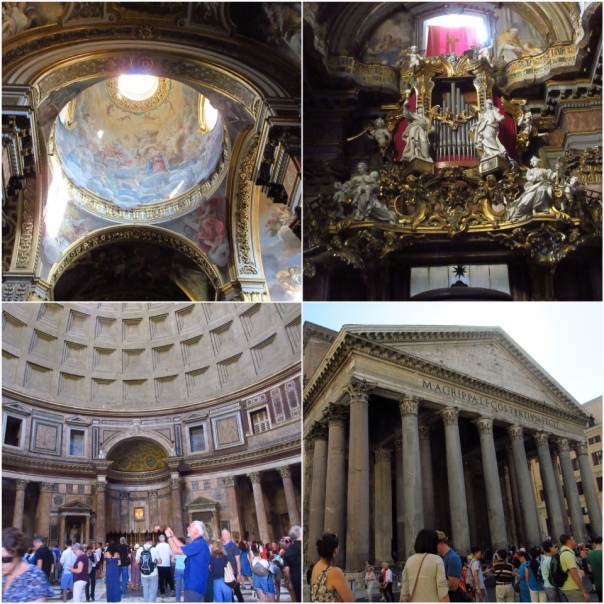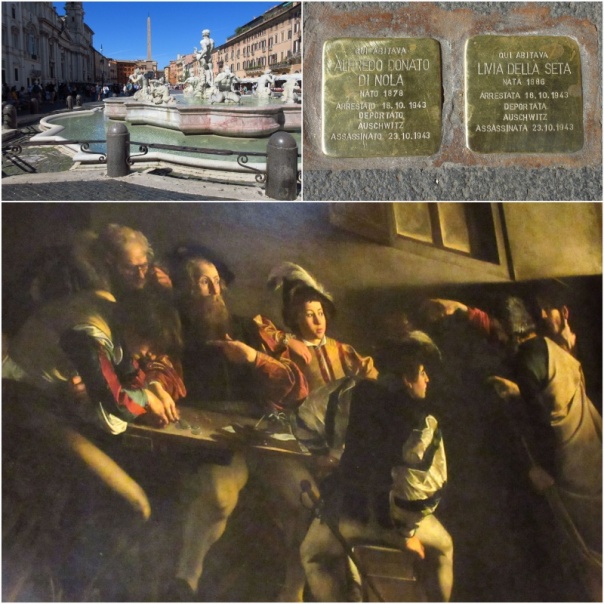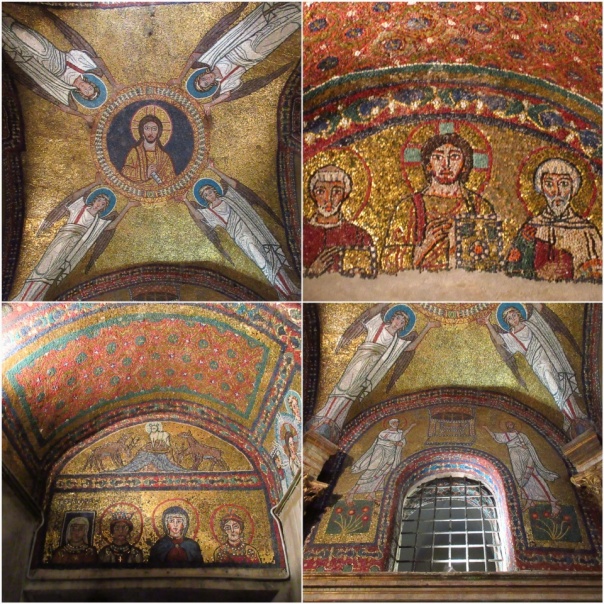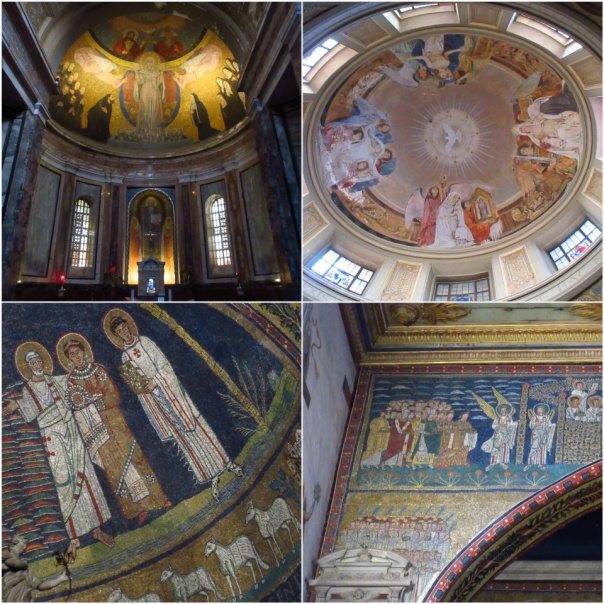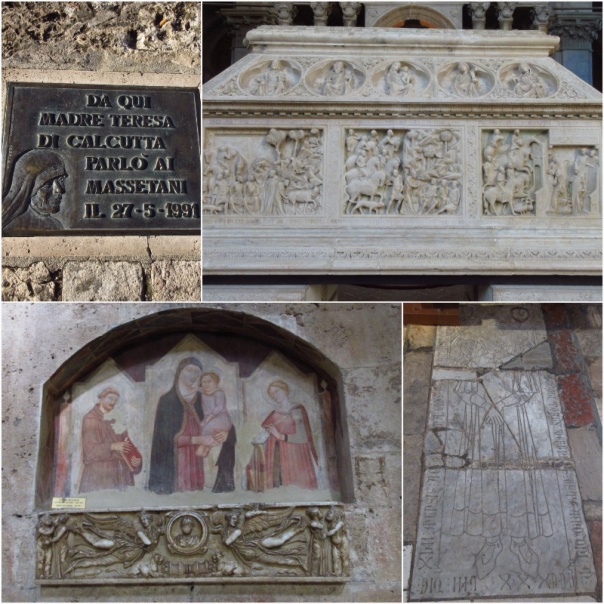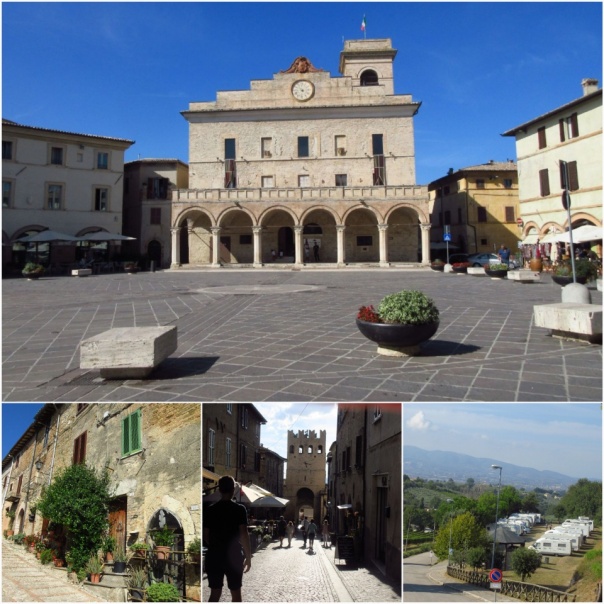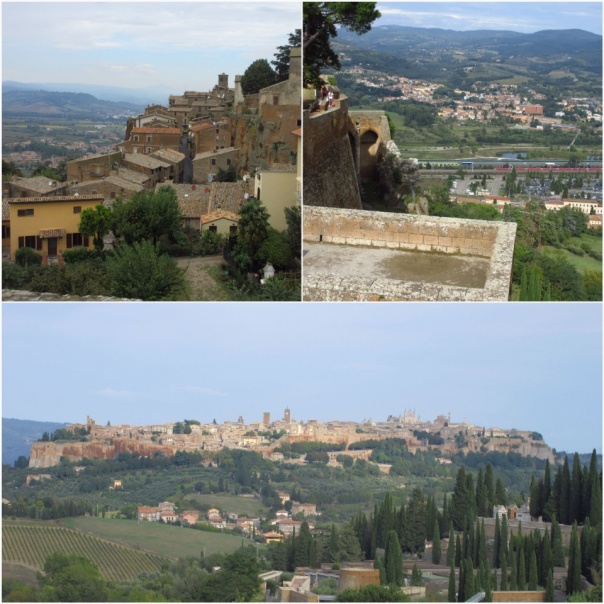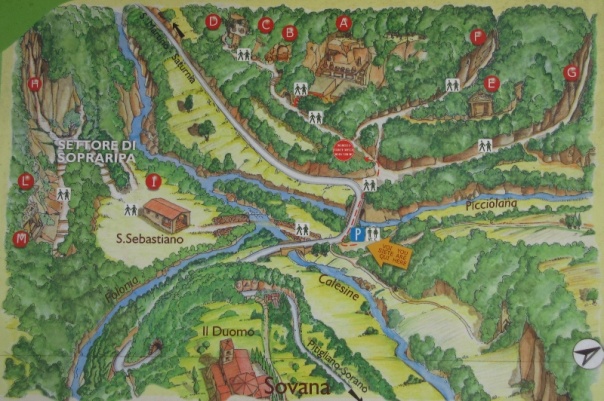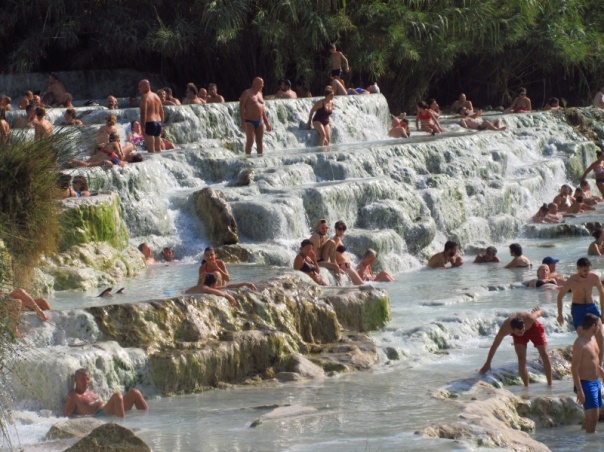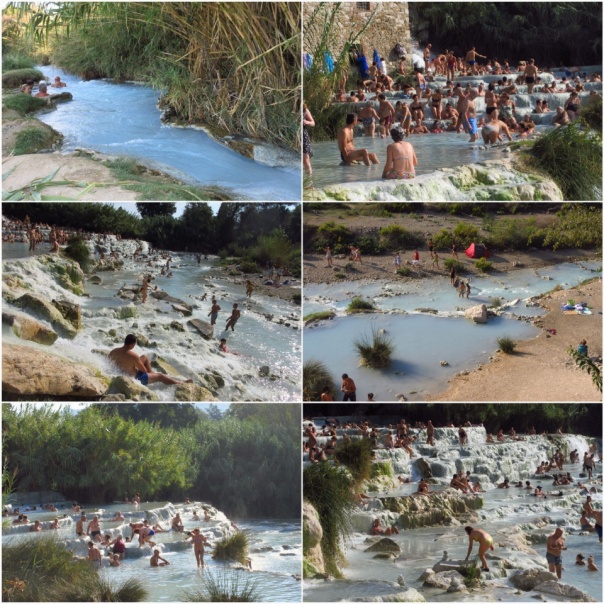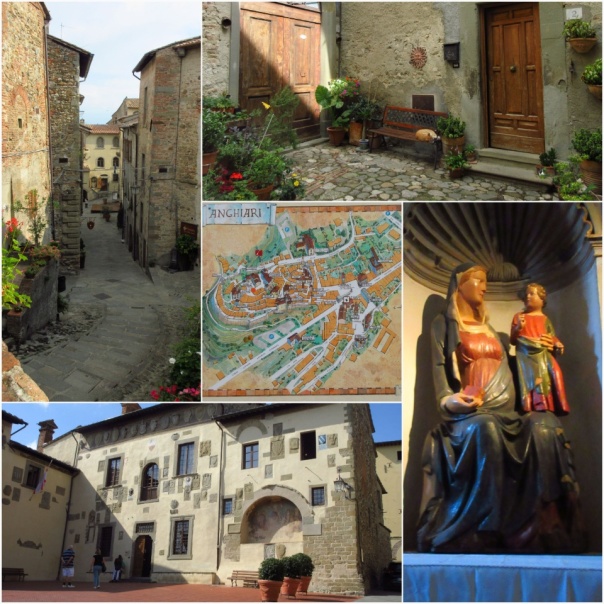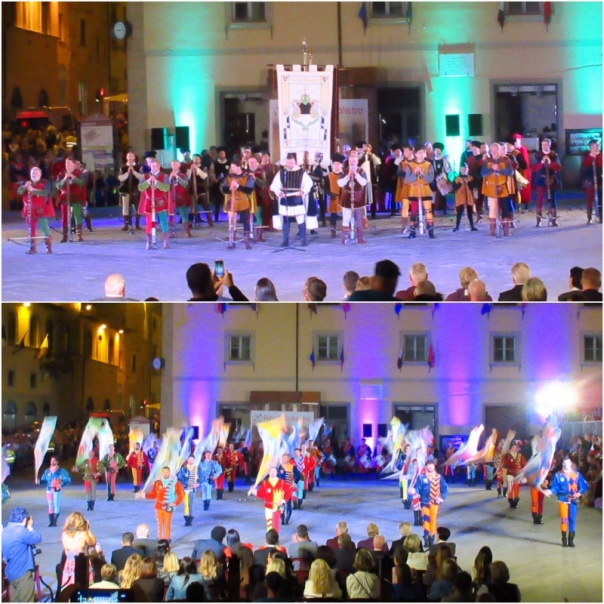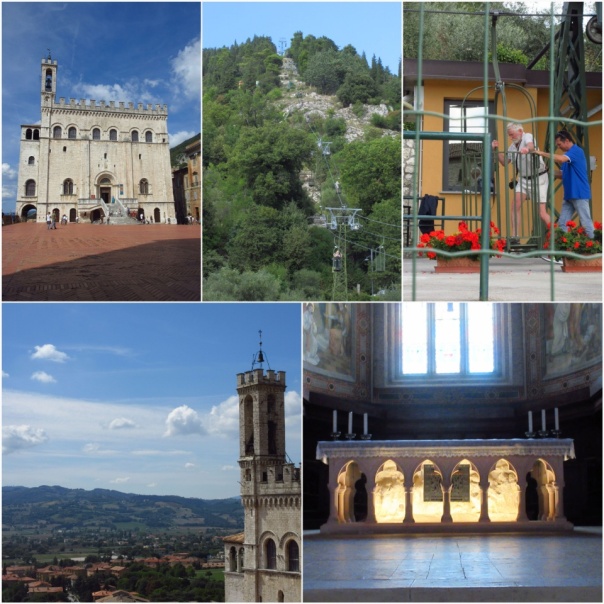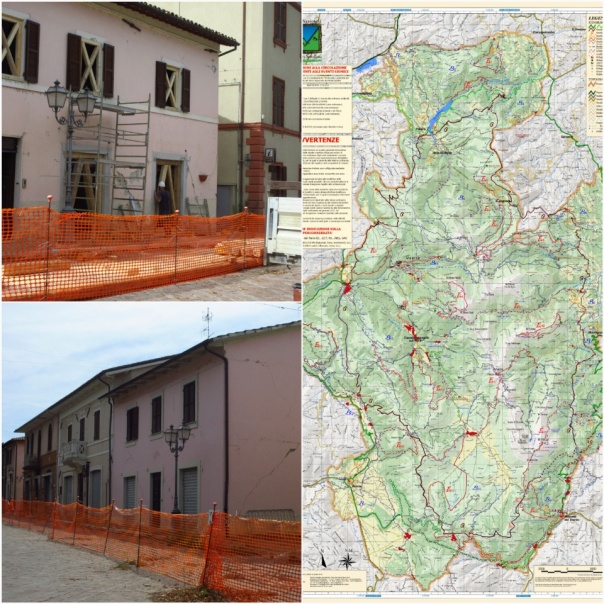Friday 27th April. We set off toward Portsmouth in Molly, our new van, and had our lunch in the very wet New Forest, before driving through torrential rain to the port. We were loaded onto the Cap Finnistere and easily found our cabin which was on the deck that also had seating and restaurants. We had forgotten just how nice Brittany Ferries were, ( We had been very unimpressed with a DFDS ferry last year) and regretted all the food we had bought with us, as there was plenty of reasonably priced food on offer.
I do enjoy sailing out if Portmouth as there is so much to see, the navel ship Queen Elizabeth was in for a refit, and we could just see the Victory and Warrior through the mist. Sallyport also always looks charming, even in the rain. I managed to sit in the lounge area until the sea became ‘lumpy’ as we reached the western approaches, when I made a quick dash for the cabin. I think that any form of cruise is totally out of the question for me!
Saturday 28th. The sea gradually abated as we sailed into The Bay of Biscay, and when I eventually got up the sun was shining, and it was quite pleasant. However as we approached Spain the clouds gathered again and by the time we docked at 17.00, it was raining and no warmer than when we had left England. Once I had a signal I started to check the weather for our proposed route I saw that heavy snow showers were forecast for Tuesday morning. I think I may have given this diary the wrong title. We have already spent more nights in this van in the snow than any of our previous vans put together, the first incident being on the third day after her collection in November. I think we will have to amend our plans.
I had forgotten just how spectacular the route south is from Santandar. The rise is so sudden and the hills and valleys beautiful, even through the rain, which stopped when we reached where the countryside roughly flattens off. The sun came out and in the distance we could see the Picos covered in snow. We stopped for the night at Alar del Rey, the aire had disappeared but we easily found a spot beside the Canal du Cantabria. I didn’t know that Spain had any canals, thinking the land too mountainous, this canal looks maintained but little used, however there is a newly renovated warehouse adjacent. It is interesting that the spring is even later to arrive here than at home!

Sunday 29th. A bitterly cold night, woke up to put on a jumper at midnight! And still cold. Why did I not bring winceyette pyjamas, and thermal vests, long socks and big waterproof for the daytime?
We had a look at the Canal de Castilla, which starts in this town and runs down to Valladolid, I would love to know what was transported. The swallows were much in evidence over the canal. There was a magnificent restored warehouse all ready to be an interpretation centre but was sadly empty, and had been ready for use for some time. We drove on through far reaching views and past the San Miguel Arch, last vestige of a church and village that stood here in the 12th century. As we took pictures we heard our first cuckoo.
We found a place in the aire at Burgos and went out to explore. I was wearing so many layers but it hardly felt the 6′, with horizontal sleety showers. We firstly made our way to the elaborate Gothic cathedral which is noted for its details. There was so much to look at but what stood out for me was the wooden carved screen in the Capilla de St Ana, which I think told the story of the tree of Jesse. Also the star vaulted central dome, under which lies the tomb of El Cid, and in another chapel two unidentified marble tombs.

We then battled through the rain to the new Museo de la Evolution Humana, which details finds made at Atapuerca, N of Burgos, in 2007, where Europe’s oldest human fossil remains were found, dating back to 850,000BC. There have been subsequent finds at the spot spanning many stages of evolution. There is also a floor devoted to Charles Darwin, all most impressively displayed.

Going to be 2′ overnight rising to 3′ by 10.00!
Monday 30th. Another cold start, though possibly not quite as bad as previously, then we drove SE to Soria, and the South to Medinaceli. There was very little sign of spring, and the trees were not even showing buds. Sheep were still corralled into barns, and there was snow on distant hills. We crossed the infant Duero at Almaden, and wondered about following it East from Porto on our way back.
We did not hang about on our way as imagined that the aire, which was described as popular and scenic, would be busy, so were surprised when we arrived to find only a couple of vans and a handful of cars parked. It might be the weather which has snowed quite heavily since we arrived, and a forecast of -1C for the next two nights! I drew the village from the van, certainly not suitable for sitting outside! We bucked up courage to explore the village which is picturesque in a touristy kind of way, and well cared for. There was an imaginative archeological museum, which had worked hard on simple re-creations, and there are two impressive Roman Arches! The central square was being replaced and everywhere very quiet, tomorrow might be different as it is a bank holiday.
Tuesday May 1st. We slept in, I think we are confused by the light here, it stays light till surprisingly late. We decided to celebrate May day, and sunshine, albeit with v cold wind, by eating in town, and took our seats in La Ceramica st the prompt time of 13.00. Helpful staff made choosing local dishes easy, bread soup, and shepherds breadcrumbs were tastier than they sound.
Later we went for a walk around the edge of the town. Far reaching views up several river valleys. It was obvious that the town was much larger than now, as there were piles of rubble under the edges of the hilltop. We found the Puorta Arabe, and in the valley could identify a Roman aquaduct, and Iberian/Celtic settlement on opposite hill. We walked round to the castle that had been built by the Moors in 780, and we intrigued by the well restored keep with locked door. We scrambled round trying to look inside and were surprised to see the village graveyard inside! Later we found an impressive Arabic Mosaic preserved under glass, with a house partially suspended over it.

Most of the time we were still wearing hats and gloves but I did find a seat in the sunshine and managed to sit for 5 minutes enjoying the sun! However any thought of opening windows in the van out of the question! And still jumpers and socks at night as the temperature goes below freezing.
Wednesday 2nd May. We drove SE towards Cuenca, down quiet roads, here the trees were further out and a lovely spring green. Eventually we drove past a very large reservoir, it was alarming to see it barely half full in May! Perhaps the dam was weak. We were now level with Madrid and there were olive trees and much terracing of the hillsides. The cereal growing fields were much larger.
We stopped to buy LPG which had been sadly depleted due to much use of the heating, even overnight, and were rather worried when the machine could not deliver any, even with assistance. Just hope the next fuel station can help or we have a problem. Fortunately our new fridge is all electric, so it’s just hot water, cooking and heating that require gas.
We reached Cuenca and the aire, which was small and rather expensive, but useful. We climbed up beside the river and crossed a rather precarious bridge to the city. Andy stuck firmly to the centre of the bridge, but the trouble was that so did everyone else, so passing was challenging. The views of the town and the hanging houses over the gorges was wonderful especially from the Mirador at the top . On the way back down I visited the church of St Pedro which had a fine Mudijar ceiling. The Alcaszar area, where the Moorish castle had stood had been extensively excavated and the finds well presented. The town was re- conquered by Alphonso 8th in 1177 and I was very surprised to read he gave equal rights to Christians, Muslims and Jews within the town . A shame it did not last. I was disappointed that the museum which displays audiovisuals and artifacts of the famous silent Holy week procession did not open on Wednedays.

When we returned to Molly we decided to move on, firstly to seek another LPG station, I also fancied exploring the Serrania de Cuenca, spectacular landscape East of Cuenca, so we took the quiet main road towards through Teruel, and stopped at a very cosy aire at TorreBaya, beside a small arbouritum and one of the best sports centre I have seen. It was so much warmer, now at 2,500 ft above sea level instead of 4,000 last night! Interesting seeing several flocks of sheep with shepherds. There were lots of irrigation channels between the small fields and near every village and town every inch is carefully prepared for the next season’s crops.
Thursday 3rd. We drove to Teruel, where the LPG fortunately delivered, then visited the adjacent Al Campo supermarket. We then took the minor road to Albarracin, which is restored medieval town. We visited it in 2011, and I was keen to see it again. I cannot think of another place which gives so good an idea of a medieval town, nothing jars and I was waiting for a Shakespeare play to begin. There are hotels and this time I did glimpse one small discrete shop, but it is just as if the town had been asleep for 600 years, albeit much cleaner!

We then drove south east along quiet roads through pastures, over passes and through gorges stopping at picnic spots and statues. The road was so quiet that we came upon a dog asleep in the middle of the road. We finally spent the night above Uno beside the Fuente del Arenazo, a picnic spot near where we spent the night in 2011.
Friday 4th. Up in good time, as we drove back down to the valley there was frost on the grass! No wonder none of the small holdings are planted up yet! We took the wrong road and missed the road that went through the spectacular gorge. Soon we were heading south through terracotta fields contrasting with the spring green fields and evergreen oaks. At first there were very few olive trees, then the large fields gave way to lots of vineyards, but all the vines were cut down to almost ground level. I can’t imagine how they grow and support the grapes with no wires or other supports.
We then drove through an area called La Mancha, but the only windmils for Don Quixote to tilt were modern wind turbines! I caught right of an elderly couple bent over their allotment breaking up the soil with mattocks. The light was getting noticably brighter now, even if everyone in the villages were still wearing winter coats. There were lots of poppies and another yellow flower by the roadside.
Once we were on the N322 we were surrounded by olive groves and some of the time on a ridge with far reaching views! Our problems started when we reached Carzorla. We were aiming for a campsite that proved only suitable for tents and very tiny campervans. The road had been quite challenging to reach so we decided to drive on. Then we excelled ourselves!?! At first it did not seem too bad but then we came to tiny, tiny streets, I had my eyes closed, it was awful. We drove through a square and the road seemed to improve a tiny bit but at the end was a pinch point, and we got stuck! I had squeezed out and was trying to direct though but could see no way was it possible! Horrendous! Wedged! Total nightmare.
After some minutes the traffic behind calmly backed, Andy squashed back out , at the end of that bit did a 12 point turn and squeezed our way back up the streets which did not seem quite so bad in comparison with the place we had been stuck! And the Spanish drivers were so understanding and patient, no shouts of abuse, and we deserved it! We then found the aire on the other side of town and drank large amounts of rioja, and I don’t usually drink much!! This experience definitely comes under the category ‘Eat a live toad for breakfast and nothing else will seem so bad all day ‘ I might suggest 2 toads. Only damage sustained was a slightly grazed bumper above the wheel arch and mirror guard! And totally wrecked nerves!
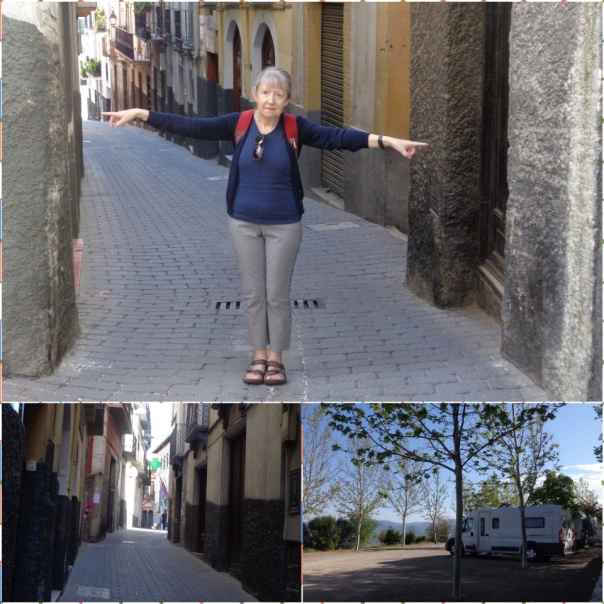
Saturday 5th. A calm day wandering around the town. We found the spot where we had been stuck, Andy could almost reach across it with arms outstretched! The place where we did a 10 point turn turned out to be the Balcon de Zabaleta, a famous view point over the town, and up to the castle and mountains behind.

There was a festival taking place, with flowers and branches leading up to a decorated small shrine. And a lot of noise in the square below.
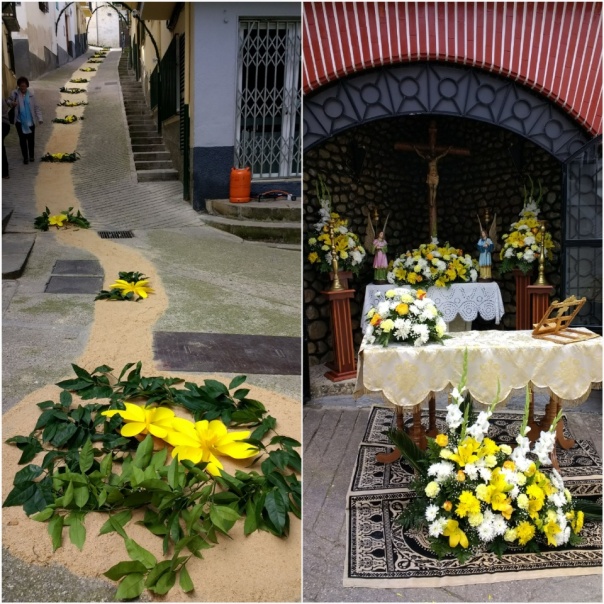
I wish Spanish shops were a bit more inviting, they seem so dark, I saw a craft shop with a very interesting window and glimpsed an Aladdin’s cave inside, but the doorway was full of the large proprietor, and it was obvious I would have to ask for something and not just comfortably browse.
We spent some time in the plaza De Santa Maria, beside a 16th century church wrecked by Napoleonic troops. We had more success with tapas this time, before climbing up to the castle which was started by the Moors and now housed a local museum. We were just in time for the guided tour! In Spanish. I would have liked to see more than the keep.

Really tired when we got back to the van but we had been up and down a lot of hills. Just in time before the rain started. We have seen lots of wild flowers, and swallows and house martins nesting.
Sunday 5th. We had intended to explore the National Park on our doorstep and even do some walking, but the day dawned grey and with rain forcast for later in the day we had had enough. Patches of blue started to shown as we left, but too late! We drove along a ridge on the very ridge of the park, so many ancient olive trees. Then through a region with many fruit trees, when we stopped I went to investigate and decided by examining the young fruit they were peach trees.
We reached the coastal strip at Mojacar, ( or mum’s car as the spell checker tried to tell me), low rise development but still more than we would like! However Camping Sopalmo was very pleasant, a small tidy site with helpful owner, even if I did disturb his Sunday lunch. Sunshine was lovely though with keen wind. Still not as warm as UK!
Monday 7th May. Peaceful day at Camping Solpamo. It was nice to just relax in sunshine at last during the morning, as well as catching up with jobs. During the afternoon was followed the track on the winter watercourse down to the sea, which naturally was further than it looked. It was surprising how many plants were thriving in such uncertain conditions, and that all the flowers were yellow!
We were very surprised to see a few campervans and caravans drawn up by the shore, and agreed that we did not fancy stopping there for the night, not remote enough. The track and coastal path continued and we followed it as far as a defensive Moorish lookout tower, Pirolicu Tower, which had impressive views. We had a very welcome beer at a beachside bar, and looked at a 18h century tower, Macenas Castle, that had many similarities to a martello tower at home. We then had a hard slog back up the watercourse, only enlivened by a flock of sheep following their shepherd.

Tonight might not be as peaceful with a baby of Alex’s age in the adjoining campervan. They seem to have an inordinate amount of gear in a very small campervan.
Tuesday 8th May. We did not hear the baby at all during the night, and that had me worried as well. We decided to go out in the van and explore more of the Park Natural de Cabo de Gata- Nijar. The coast road to Carboneras is extremely spectacular and sweeps down to the sea. It is a shame that the little cove was disfigured by an almost complete resort building that has been abandoned unfinished, there are so many of these, victims of the economic downturn.
After Carboneras I was surprised to see a large oil ?? Refinery. We decided to go further on to the park, so rejoined the motor way, then turned off at Campobermoso, a very poor town with large immigrant community, whom I assume work in the sea of polytunnels that surrounded the town. I knew of these tunnels, but nothing prepares you for the sight of so many and will make me re-think about food out of season!
Once in the national park again, the scenery returned to its desert like appearance, with lots of wild flowers. I was amazed at the amount of abandoned terracing, had the land once been more fertile, what had they been growing and where did they live? We came to the small seaside village of Las Negras, which I guess had once been a tiny fishing village, and now was devoted to very low key tourism. Most places were shut up, and a few tourists looked lost, apart from in the single active lively restaurant. The coastal scenery around was spectacular but the coast path was more than we could comfortably manage. We have been spoilt by the scenery around the coast of Dorset, and Devon and Cornwall.

We found an excellent supermarket in Carboneras, and solved the underground parking problem with parking in a side street. ( We are trying the dark greeny red tomatoes that are reputed to taste better – Raf tomatoes, I will report) . We then returned to Camping Solpamo, an exceeding good tiny campsite.
Wednesday 9th May. We left the lovely campsite, and drove out via Molzjar. The promenade ( think Eastbourne) seemed very pleasant after yesterday, perhaps we should have come here and eaten Italian ice cream, then wandered up to the old town above. However now we had to press on because I want to get to the Festival of the Courtyards at Cordoba, which I have had on my ‘ things to do’ list for some time.
We passed Sorbas, an interesting town set above a gorge, then past several ‘Wild West ‘re- creations, which were tourist attractions above Almeria. There was a lots of snow on the Sierra Nevada, and at the previous campsite the owner had said they were skiing there till last weekend! The mountaintops were covered in clouds. Guadix also looked interesting, with lots of troglodyte dwellings, some of which could be seen from the road.
There seemed to be loads of buttercups on the verges round Granada. I had tried to get tickets for the Alhambra, once I found you could book and print the ticket at home up to 3 months ahead. But when I tried I found all the tickets for May and June had been sold, probably to ticket touts which is why they are available locally at inflated prices. I could have booked for July! Now I know the system, I’ll book tickets well in advance as soon as we book a ferry!
Once past Granada there were green fields and vast acres of olive trees, I think this landscape suits me better than the desert one on the coast. I enjoyed the wild flowers but found the arid scenery rather depressing. We easily found the aire at Priego de Cordoba, and after a cup of tea set off to explore. It was a walk into town, past the bull ring, but through interesting streets with more normal shops, closed till later. The area of tiny streets around the castle was full of flowers and really charming. There was an impressive Balcon de Adarve, with views over the countryside. Elsewhere in the town wás an unusual fountain, with 3 layers. As we wandered back the shops had opened and the town was full of bustle.

Thursday 10th May. Quiet night at the aire and off in good time as wanted to get to the campsite promptish to get a space. It wa very grey, but lots of wild flowers by the roadside. Also lots of olive processing plants, and above the groves, the hills were thickly wooded. As we nearered Cordoba the verges were thick with broom, and the olives gave way to large cereal fields. No problem when you arrive at 10.30 here for space, mostly full by 16.00, I was immediately given a map of the Courtyards open to see.
I was told at the campsite they opened all day, I had read they opened at 17.00 during the week, and from noon at weekends. In reality they open 11-14, and 18-22.00! So it was as well we went straight into the city. I was not prepared for the large queue st the first one we tried to go in, but quickly found this was because they were tour groups, and give that one a miss, and go onto another.
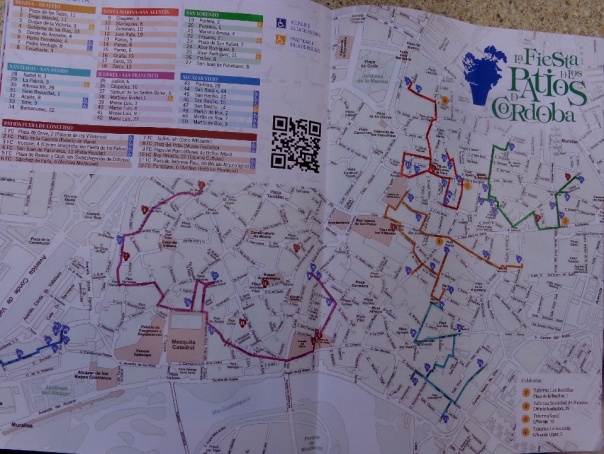
The courtyards were every bit as charming as unexpected. Such a riot of colour, and in such a small space. And the rooms off looked cosy and cool. A bit salutary to think that originally the women would have been expected to live in that area and not go beyond the front door! After a disappointing tapas we came home for a rest before venturing out again.

We have been very confused about the Plaza de Colon, we keep going through it, there are all sorts of places named after it. Eventually the penny dropped (!) when we saw a tiled picture which we took to be Christopher Columbus!!
The courtyards seemed much quieter and more atmospheric during the evening. One of the courtyards had a group of singers which really added to the atmosphere. As we were preparing to go home, a local suggested we went with him so he could show us the winning balcony. It was on a modern house in a small development, it is hard to see how such a solid mass of flowers could be achieved by individual pots. He also showed us the patio of the president of the society, which we had already visited but it was good to see through the eyes of a local.
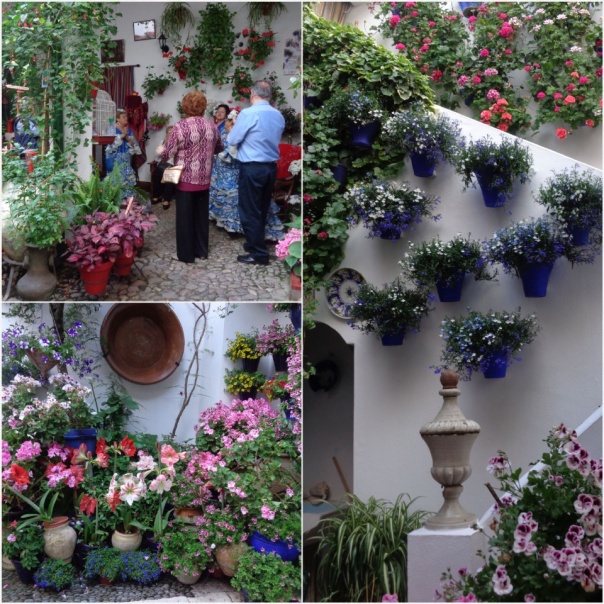
Friday 11th. Andy could not not face courtyards all day, so I wandered into town through the excellent parks and boulevards . It had been my intention to quietly sit and sketch in a peaceful courtyard, but a. I’m none too good on plants, and b. The courtyards are all far to busy to sit peacefully! I made the mistake of trying to visit the Alcazar Viejo patios, all close together. A big mistake. It was crowded out, with enormous queues, large groups. They are all wheelchair accessible, and each time a group of such arrived, or a group of nursery children, they were shepherded in, so we waited even longer. I should had given up long before; then had a lovely walk along beside the river, and much quieter patios in a another area, and past a couple of prize winning balconies.

Our evening stroll was much more pleasant, around more remote courtyards, and came across another group singing and dancing.

Saturday 12th. The night was punctuated by the cries of tawny owls who seemed to be perched in the branches just above the van. They woke us several times!
We had read that the Mezquita was open from 8.30 -9.30 and hoping that this would be quieter, as tour guides are not allowed then, we left the site at 7.45! The city was largely deserted and it was very chilly, so we were surprised to turn a corner and found a queue, at the wrong gate it transpired. It was quieter than later, and worked its usual magic.
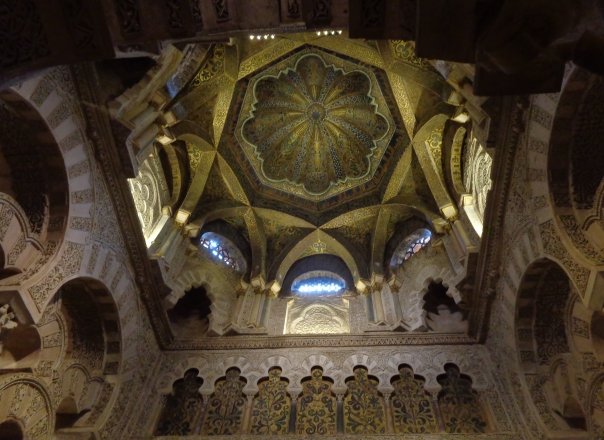
The Mezquita is definitely my favourite building. I’m always impressed by the glimpse of the 3rd century floor from the first church on the site, for which there is documentary evidence; and most of all the mihrab, which shines with the 1,600 kg of gold cubes sent by the Emperor of Byzantium, as a gift.

I had hoped to sit drawing in the baroque cathedral in the centre during the mass which followed, but was spotted; when I made my way out later it was great to have the long aisles of columns to myself for a moment .

We found somewhere for a second breakfast, then walked through to the Roman bridge, for views over the city.

Later I tried a drawing in the courtyard outside the Mezquita but it was just too busy.

I wandered back through the streets passing a Roman temple and popping in to two churches, which happened to have weddings going on inside. Very long veils seem to be the order of the day in Spain. As in Greece, some of the guests seem to be spilling out of adjacent bars.
I then reached a square where there was Flamenco singing and dancing. I had read that a gravely voice and lots of feeling was essential, the singer had this in spadefulls. And I’m sure that the dancing was also most authentic, the female dancer especially put such feeling and verve into her dancing, throwing herself about, such accented moves.
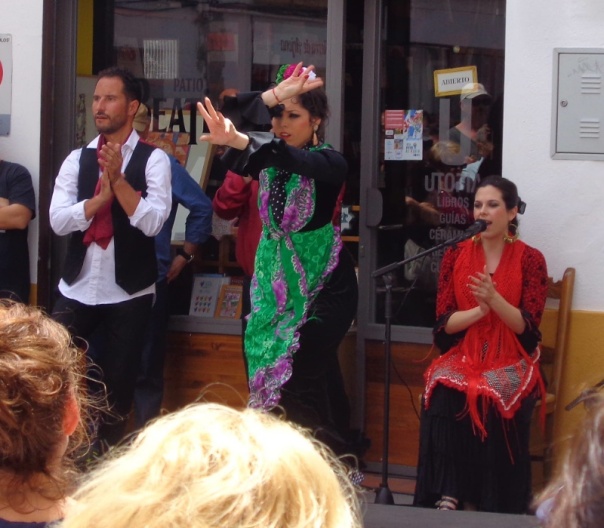

I then caught the bus home to gather strength for the last lot of courtyards during the evening. We visited the last group of patios. I think I had managed to see about 40 of the 50 available to view! The queue outside the overall winner had to be seen to be believed. The police were in attendance to keep the road clear. The thing that made the patios charming as well as the flowers was the collections of memorabilia tastefully displayed. And the decorated wells that looked still used. Amongst the last was a really tiny patio that was incredibly cosy.

Afterwards we joined the crowds in the Plaza de Corredera where we sipped sherry till the promised flaminco concert started at 22.00. However there was an incredibly chilly breeze blowing throughout the square and it was not long before we were as cold as we had been in the morning, but with no hope of warming up. On our way back to the bus stop we glimpsed a procession, and watched an incredibly heavy statue and plinth make its unsteady way down a side street, with followers.
Sunday 13th. We came south from Codoba through lovely rolling countryside with few trees and far reaching views. The edges of the roads were bright with wild flowers, especially very deep red poppies. We aimed for the aire at Olvera, but the access road was blocked. However we managed to park and have a wander, up to the Moorish town centre at the top of the hill.

We had a drink in a tiny bar, called the Torre de Pan, then took the scenic route east, which included busy mountain passes, ( it was Sunday) up to Grazademia (which we recognised from our last visit, supposedly the wettest place in Spain) then down via incredible views to Arcos de la Frontiera.
I had very fond memories of our last visit to the town in 1998, I remember climbing up through the town in brilliant sunshine, declaring I wanted a house here. Well, I certainly did not recognise anywhere, though I am sure we came on the town from a different angle, and I did find some charming corners, but there are many places I now would prefer to live! And definitely could not cope with the ex-pats we saw round the town.
Monday 14th. We made our way south, so many wild flowers by the roadside, I have never seen so many poppies. We tried to find somewhere to stop in Medina Sidona, think we are still unnerved by previously being stuck, as we found somewhere in 1998. Our first attempt at somewhere to stop in Vejer led us to the sea near Conil de la Frontera, and was unbelievably awful, mile upon mile of seaside shacks and hovels. The beach might have been fun and full of windsurfers, but at sometime you would have to come out of the water. I’m not sure whether the high rise developments, or miles of shacks are worse.

However with a bit of effort we found somewhere in Vejer de la Frontiera, and Andy spent a very pleasant afternoon in a lovely park beside a row of windmills while I wandered the streets of the old town, and sketched.

Vejer was very pleasant indeed and the old town unspoilt. Apparently the women of the town had worn an outfit very similar to the full hijab, the Cobijado, a full long skirt and lined enveloping hood, until discouraged by Franco, but seen even up till the 1970’s. Interesting as we associate the outfit so strongly with Islam.

We then drove south towards Tarifa, and soon the Altas mountains appeared looking as close as nearby scenery. Enormous fields of wind turbines. And swarthy looking bulls with handsome families. However the countryside was green, with cork oaks, and would not have looked out of place in England. The campsites here looked better, and miles of deserted beaches, apart from the windsurfers. We parked in the run down aire at Terifa with the other hippies!
Every street in Terifa had a motor home parked on it. We did see a notice that said motor homes were not allowed to park anywhere in the municipality, and worried for a bit. The sea front was a mixture of smart, and run down port. The town has some surprisingly smart houses and shops, as well as a Moorish old town and castle. The story goes that when Guzman El Bueno was threatened with the death of his captured son unless he surrendered. He threw down his own dagger from the walls of the besieged castle, to kill the boy and refused to surrender. The only trouble is I’ve heard the identical story when visiting a Cathar castle in France, as well as one in Romania. A lot of it about.
We decided to risk a night in the car park, along with 20 others in varying states of repair. Really a shame this is not reinstated as a proper aire, that could earn the town a steady income, then perhaps tidy up all the vans scattered across the town.
Tuesday 15th. Uneventful night, we drove towards Algeciras to try to get a gòod view of Gibraltar, but there were no spots for photographs. Africa looked no further away than the Isle of Wight does from the mainland. There was a limited view from a beach, and then we tried a road to the lighthouse at Pinto de Carnero but the road drove past to an unexpected modern village.
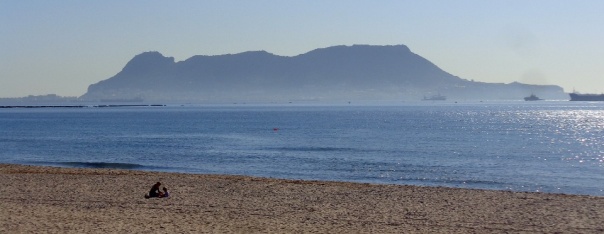
We then retraced our steps to Terifa, and tried to find the campsite we remembered stopping with the children. We drove backwards and forwards and would still be doing it now had we not pulled into Camping Torre de la Pina ; admittedly we have road noise, but this is made up by an uninterrupted view of the sea and Africa from the open van back doors. The washing dried almost as soon as we put it out. And the receptionist listened to my description of the site we were seeking,and said it had new owners and is closed at the moment!
Wednesday 16th May. A lazy day at the campsite, Torre de la Pina. Gales were forecast and as we walked along the sand at low tide we were sandblasted by sand whipped up from the dunes after we had walked from the rocky outcrop on which the site is situated. The stata is pushed into weird shapes in the cliff and there are rows of ‘dragons teeth’ pushing up through the sand.

The other sites may be more sheltered, often amongst trees but they do not share the excellent views we are enjoying all the time. There were very few windsurfers or kite surfers around today. We are identifying the many ships using vessalfinder.com. I could see the wind turbines in the African coast whizzing round. Apparently the extra strong easterly winds here are often caused by the air being trapped between the Riff mountains and Southern Andalusia, and called the Levante.

Thursday 17th May. Another walk along the sand, this time much more pleasant with a more gentle wind, lots of sandpipers along the sand. There were an enormous number of windmills as we drove north, then skirted round Venez and north towards Jerez. Mlany egrets on the salt marshes around El Puerto de St Marie, from where we caught the ferry to Cadiz last time. We easily found the aire, at a motor home dealer on the Av Tio Pepe.
After lunch we caught the bus easily into Jerez, and wandered around, past impressive church fronts, St Miguel.

And the cathedral, with Tio Pepe, who is everywhere in the town.

We got totally lost getting a map totally upside down and then blaming spanish maps! Jerez is supposed to be the origin of flamenco, as well as the heart of Andalusia. I’m not sure I would go that far as I got so interested and involved with Cordoba. We will see.
Friday 18th. We thought we had better start our look for sherry. We had considered visiting the Tip Pepe Bodega, the works dominate the town, but decided that it would probably be too busy and commercialised, so revisited the Sanderman Bodega which we had been to 4 years ago, and were not disappointed. We had forgotten so much about the process which was very interesting, how the wine is kept a constant temperature,and is blended as it matures in oak casks.

We all became very convivial as we sampled the sherry afterwards, a couple who were touring for a fortnight and two girls who had spent their winter teaching Spanish as part of their degree course, the girls said they had never got used to Spanish meal times, and definitely not an evening out starting at 2am and going on till dawn. They said even at uni they used to be home by 3! We stumbled out into the sunshine afterwards. I remember feeling squiffly before but somewhat worse this time!
We came upon a locals’ cafe and ate the menu of the day once it had been translated by a friendly customer! My portrait as we sat in the cafe was noticeably looser than usual but rather better. I must drink before I draw! We then wandered round the town, before a shop- up in a convenient supermarket, we noticed that the car park had been an old winery, we had heard that sherry had been suffering a downturn in popularity despite local enthusiasm.
Saturday 19th. We collected the sherry from Sandermans, fortunately I noticed it was the wrong box.
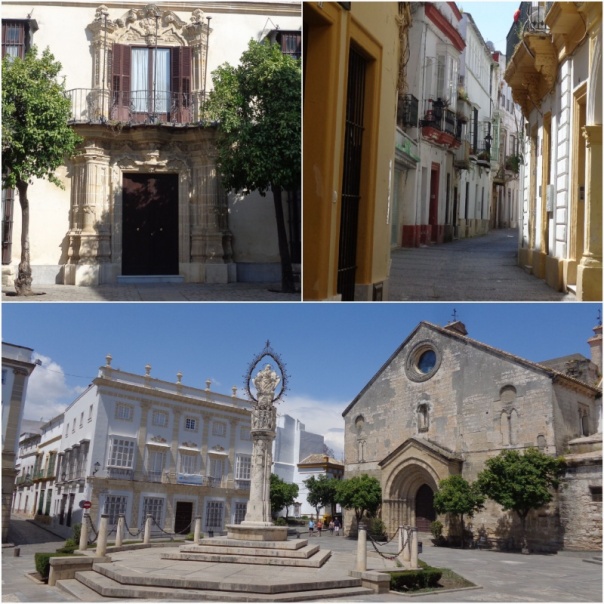
I then wound my way to the Alcazar, where I spent a happy morning exploring. Whilst climbing the stairs in the Baroque Villaviencio Palace within the walls, I suddenly realised I had been here before, and further recognised the archeological remains in the grounds, but could not remember seeing anything else! Oh dear!
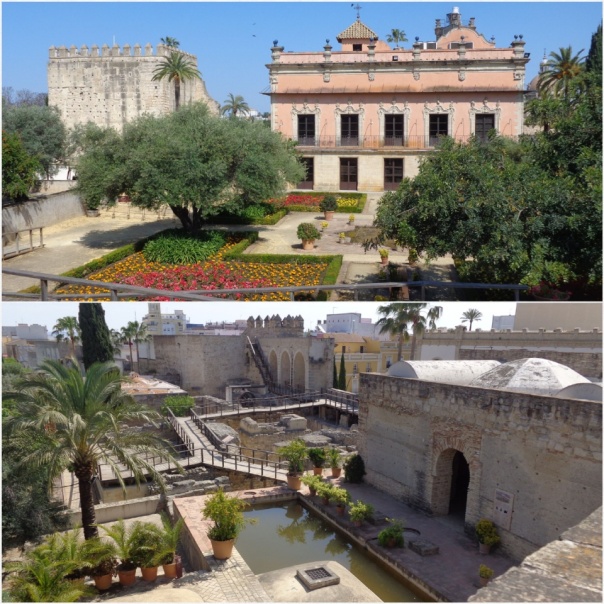
The whole complex was most interesting, the small mosque dated from the 12c. It had survived as it had been converted to a chapel. Also well preserved were the Arab baths, and the 10th-15th cent. archeological site included reconstructed waterwheels, cistern and reservoirs which also served the gardens, and castle in times of siege.

There were the remains of a lovely Royal pavilion, and wonderful views over the Alcazar and beyond to the Catedral, from the battlements. There was an interesting ‘country gate’ which was difficult to defend so was very narrow, with 3 sharp bends. In the palace there was the reconstructed municipal pharmacy from the 19th century.

After a happy time sketching, I joined Andy at the Cruz Blanca, where we enjoyed the tapas and caught up with pictures of the royal wedding, toasting with sherry of course. Then we had a wander and then had tea and pastries around the corner. Somehow just did not want anything more than strawberries for tea.
Sunday 20th. We left Jerez in sunshine, and drove through quiet Sunday towns, where we saw cherios and chocolate vans drawn up outside churches, with a queue already formed. We drove round the Donanas park, and Seville, and later saw a row of storks with purpose built nests on a row of pylons.
We crossed the wide river into Portugal and were not a little out to see a demand that all ‘foreigners’ had to pull into a side road and put in their credit cards to pay an undisclosed deposit to use the motorways. We don’t want to use expensive motorways and think countries are best discovered on quiet side roads. The nearby police office said it was not responsible, but suggested if we ignore the machine and come off on the second turning we could use national roads. Not the way to welcome visitors!
We suppressed the strong urge to turn back and return to Spain and drove on through very poor roads to Tervira, when we stopped beside the river a short walk from the town. As soon as we parked a thunderstorm broke over head, and it rained for the afternoon. Mmm mmm!
However we ventured out once the rain stopped and were quite taken with the town. Lots to see, and although lots of visitors did not seem to be spoilt by tourism, and retained a lot of charm.
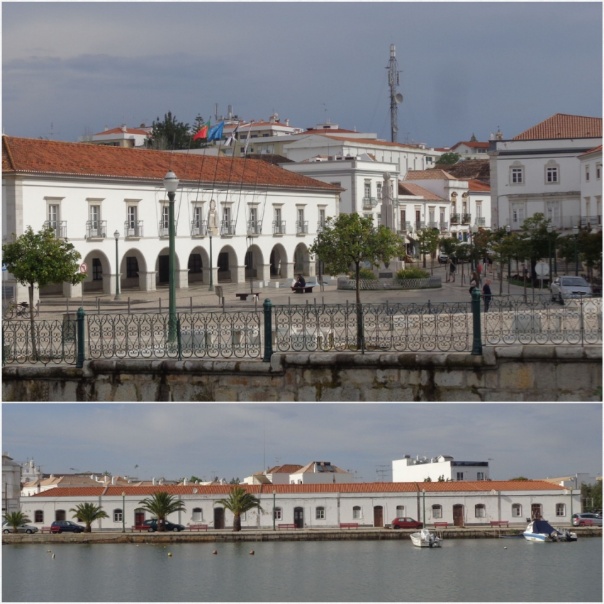
Monday 21st. We had a shop up first thing at the market, which fortunately was adjacent to our parking area, then wandered, into town. I enjoyed glimpsing in the haberdashers shop, which looks just like the one around Mount Road I remember from the early 60’s. I must find something to buy in there. Then into the excellent hardwear shop, which sold every size of shackle and screw ever invented. The town is most attractive, with pleasant streets and a lovely waterfront.
We walked up to the castle, which is reputed to have been developed by the Phoenicians and the Romans before the Moors built the one we climbed over. It contains a lovely little botanical garden.

In the afternoon took a ferry past the salt pans, over to the Ille de Tavira, which is a long sand spit just offshore.

On our return I wandered round sketching. I asked in the tourist office about the several large derelict buildings overshadowed by enormous chimneys, a question that was received with some discomfort. They are apparently disused tuna canning factories abandoned in the 1950s onwards. A chimney we can see from the van, adjacent to a road, has a most perilous crack, another has a resident stork. However we have been able to have our back windows open overlooking a tidal disused salt pan, that has had a heron feeding and martins darting over head. A most pleasant evening stroll around the town.
Tuesday 22nd. First job was to find somewhere to sort out the doings, as we are wild camping with lots of others on a permitted spot within such easy walking distance of the town. The local campsite that was supposed to offer services was closed, so we drove a few miles eastward to a tiny resort with a large aire that was stuffed with large campervans, ( no vans at all like ours). As far as I could see the only attraction was a nearby beach, the village had little to offer but holiday apartments. Yet some people seem to have been there a long while. We were very glad to pay our money and escape back to our view over the salt pans.
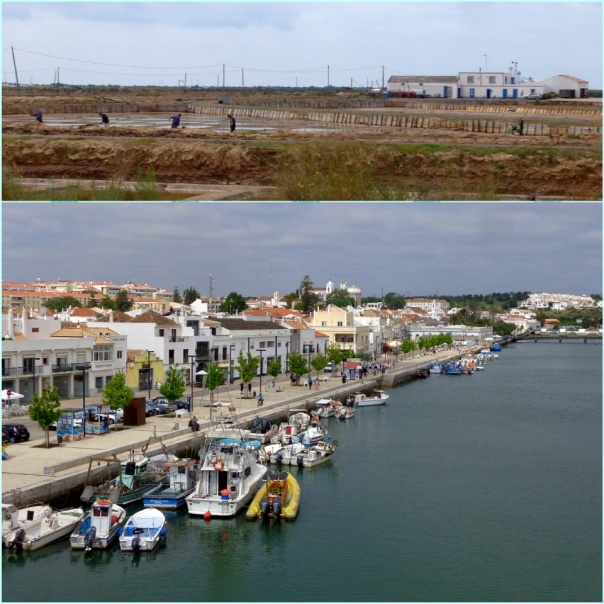
I wandered into town after admiring the view from the bridge over the Rio Gilao, I went to the Islamic Museum, housing local finds, then up the hill to the Palacio da Galeria which housed local art works, and also a UNESCO initiative showcasing the Mediterranean diet. They had chosen a number of local towns across the Mediterranean, (yes, I know Portugal does not touch the Med but apparently it counts) and was most amused to see another highlighted town was Koroni, in the Peleponesse, another town which we are very fond of!

After lunch I went to see a short Fado concert, performed in the Igreja da Misericordia, lined with blue tiles dating back to 1760 and an incredibly ornate altar piece. I was most impressed with the fado, which in today’s presentation was much lighter than the Flaminco enjoyed last week, also featured a special 12 string guitar. We ate out into the evening choosing an understated restaurant.
Wednesday 23rd. We had a good shop up at the market, fish, including freshly caught tuna off Tariva, meat and far too much fruit including strawberries, nectarines and cherries. We bought a fruit we did not recognise, which when we cut it I remembered it was a custard apple. We then drove WSW north but parallel with the busy coast through lovely countryside. When we stopped for lunch we took pictures of the rock citrus which smells so strongly everywhere, the countryside looked barren, and had possibly been cleared some time ago following a fire, but when I looked around there were 7 different wildflowers at my feet.
We passed an elderly gentleman riding a scooter, who had his walking stick hanging from his handle bars. In a primary school playground the children were wearing an overall, I remember thinking what a good idea the uniform was. I had also forgotten the charm of Portuguese chimney pots, with their varying designs. I also saw regular buildings beside the road, that turn out to belong to road maintenance men, the buildings had distances to the nearby towns picked out in tiles.

Eventually we drove into the depths of the countryside to an isolated Dutch aire, close to Sao Bartolomeu de Messines. We were the only customers but the owner reported the site was already 70% full for next winter! We could manage without hookup, with our 2 solar panels and 4 batteries but I don’t think we are going to try, and the owner expressed surprise that people could cope with being in one place for that long. I definitely need my friends and my toys, not to mention my grandchildren for that long over the winter!
An afternoon stroll showed us so many wild flowers, yet the owner said they were past their best.

Thursday 24th May. After a lot of dithering we decided to stop on for the day at Camperstop Messines, it really is a lovely spot, and feels so far from anywhere yet only few miles inland from the hectic coast. In the morning I went for a stroll up a nearby hill, I was initially worried by the sound of barking dogs from a nearby farm, but as I climbed higher, could see that they were driving a herd of sheep onto a neighbouring hill. Interesting, as aĺl the sheep we had seen in Spain were being led by shepherds, which makes the biblical stories so much more understandable.

After lunch we had an amusing effort of trying to connect a sunshade to the van, as well no one was watching, then had another wander. We were amazed just how quiet the countryside seems here, often no sound at all, or at most sheep bells or birdsong. I counted 4 sorts of butterfly when I went through the wild flowers walk again, including one that was indistinguishable from the leaf it had landed on.
It’s just a shame it was so chilly for quite a bit of the day, with a cool breeze, and little better forcast.
Friday 25th. We woke up to light rain which gradually cleared as we headed for Monchique, up in the hills before the east coast. A policeman signalled for us to pull over and then decided it wasn’t worth the hassle. The EN 267 took us through lovely wooded hills, Andy said it could easily be the Amazon jungle. We stopped for shopping in Monchique, outside the supermarket were a row of washing machines.
We joined the coast road, which we had travelled in 2014, and stopped once more at the Praia do Amado, beyond Carrapateire, a lovely beach with rust coloured rocks and very popular with surfers. The entire Cote de Vicentina is an unspoilt 120km national park, which stretches north from Sagres, and the ‘corner’of Portugal.
We took a walk along the cliff path, past a newly furbished fishing cove, with purposebuilt huts for the fishermen at the top of the cliff, and the site of a 12 century Islamic seasonal fishing village on the cliff. We glimpsed some storks but they were not at their nesting site; and had a beer at the popular cliff top restaurant.

Then we sat on the beach, where I attempted to paint. After watching the sun sink into a veil of cloud from the viewpoint, we joined the other wild campers for the night. At sunset there were still at least 10 surfers in the water.

Saturday 26th. Peaceful night, and a pleasant wander right along the beach after breakfast. The waves cannot have been right first thing, as the surfers seemed slow to start. At lunch time we made our way up to the restaurant on the top of the cliff, Sitio do Forno, where we overlooked the Islamic fisherman’s village. The portions were tasty and very generous. Further on we could see and hear two storks doing a mating ritual on an isolated rock.

Then we wandered back, and moved back to the main road, then through Aljezur, where we turned along a rough road for 3 miles to get to Praia da Amoreira. The road follows the river valley past fields and salt pans, finally reaching a large but much quieter beach. I can only assume they are the wrong sort of waves for surfing, but look fine for belly boarding, in fact it is an ideal family beach.

The sandy beaches continue up the river, where small children could play even more safely, although the river does flow quite swiftly. We managed to get a spot right beside the dunes and the sea, a wonderful view, especially with the back doors open. In the evening I followed a small path up through a nature reserve full of yet more flowers. I learn that one flower I had noticed everywhere was a coastal snapdragon. Another, called a Hottentot fig, was a much hated invasive species.
Sunday 27th. We left the Praia da Amoreira in mist, although the surf must have been better behaved as the surfers were beginning to pour in. We drove on via Oxeceixe, a little white town with a useful collection of shops and cafes set on a steep hillside topped with a windmill. Then down the river valley to the mouth of the river. There had once been a small fishing village here, but it had been subsumed by a tiny resort, the single road that ran steeply straight down to the sea, still in existence.
We parked in the aire high above the beach and set off along the coast path, seeking coastal nesting storks. The track desended into sand which was difficult to walk on, but surrounded by wild flowers, and then we found the storks, first one, then a whole colony on inaccessible outcrops in the sea. We counted 7 nests with 2 or 3 chicks in each. We could see them so clearly, the chicks already quite a size! So exciting when dad bought home food! Over head large numbers of swifts.

I wandered on to a viewpoint where I could see far south towards Sagres and north towards Lisbon, rocky coast all the way. On the way back the storks were being mobbed by a solitary seagull who appeared to have his nest close by. We then walked down the hill to the beach and sand spit. Where the river met the sea it was narrow with high cliffs, which became more gentle inland.

Monday 29th. There as a strong wind blowing all night, which had hardly abaited by the morning. We set off for Cabo Sardao, the lighthouse a typical Portuguese one. Much more limited array of flowers. There we were lucky enough to see more cliff nesting storks, one with very young chicks in the nest, another such closer, with one stork on sentry duty quite close by and two more nests much further down the jagged outcrop. I was most concerned about the two babies in the bottom nest, whose parents had left them unattended. Apparently these storks are unique in not migrating but stay in such a perilous situation all year round.

We then moved on for lunch to the river shore opposite Vila Nova de Milfontes, a lovely spot if still plagued by the wind.

I was worried to see the development of plastic greenhouses that so blight parts of Andalusia. Drove north through Porto Covo, past Praia Grande towards Sines, which I had forgotten was surrounded by a power station and oil refinery. I thought how much it spoilt the view until we stopped for LPG for our cooking and fuel for the van! And want electricity to do the washing tomorrow! After a shop-up we went to a small campsite to catch up with our chores and spread our toys out for a couple of days. But sadly not successful in escaping the wind.
Tuesday- Thursday 31st May. Few quiet days on campsite, catching up with washing (lots) and seeing lots of wild flowers in the local unmade up lanes.

There are storks near here nesting on pylons, where special purpose built wire platforms have been provided for the them, one pylon is a proper block of flats with 7 nests on it. Weather better on Thursday with warm sunshine.
Friday 1st June. We drove east to Alvito, a small town with interesting Mudijar chapel built on the edge of the town as protection against the plague. We eventually gained admittance and were impressed by the ceiling painting, lots of musical angels including one playing an organ, while another pumped the bellows. I noticed that the pousada/castle had a reasonably priced restaurant and we had a wonderful meal, overlooking the castle courtyard. Andy was most impressed with his stuffed mushroom stuffed with quails eggs, while my chocolate pudding was the best I’d ever had, the chef said the secret ingredient was ham!

Saturday 2nd. We moved on to Beja, we first visited the castle, with views over the town. Here I asked at the tourist information about the Visigoth museum, he replied that it was closed today but after questioning said it would be open on Monday. I was surprisedat this, as most museums are closed in Europe on Mondays. When someone else’s question revealed confusion as to which day it was, we went to see for ourselves, and the museum was open. Sadly although it had lots of impressive carvings, it had nothing about the Visigoths themselves despite the fact they built the church in the 6th century.
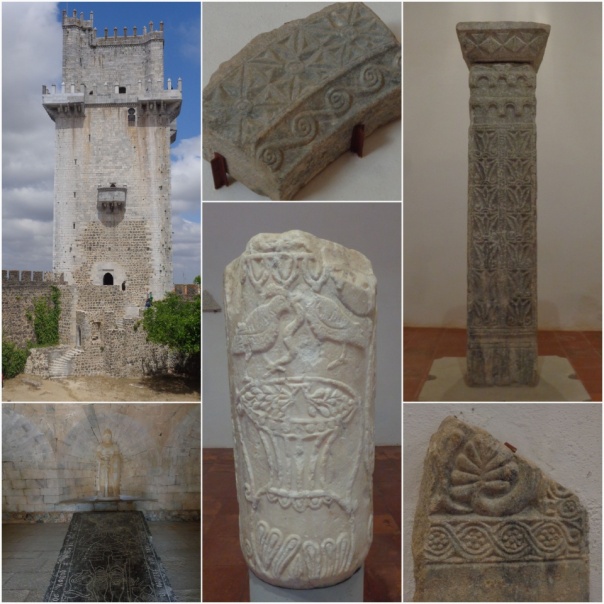
We saw two old ladies in the black long dresses, with long headscarves we used to see. We then moved on to the Convento de Nosse Senhora da Conceicao. Inside the baroque chapel was so over the top, with gold carved wood. Andy said one of the wooden angels would not have looked out of place on a fairground ride or a temple to Shiva. Lots of the tiles in the cloisters were elaborate and very old. The convent was famous in the 17th century for a series of published letters between a nun and a French cavalry officer who had been posted to the town, however the originals have never been found.

We moved onto Serpa for the night, to a very reasonable municipal campsite, 8€, which boasted great facilities including a mountain bike washing machine!
Sunday 3rd. The morning was so cold that a child was playing near a tent wearing a padded jacket and bobble hat. Serpa boasted an 11th cent aquaduct which had a huge 17th cent wheel pump attached. I spent a morning painting the quaint Moorish quarter below the walls, I then discovered that the castle was open and was able to look down on the town, and note how tiny the houses were, many seemed to have front door and two windows, and largely back to back.


We then went on to Moura, which seemed to us to be a rather sad place. We climbed to the castle, which was only really memorable for the story of the end of the Moors’ 500 years in the town. The bridegroom of the Moorish Princess was ambushed on his way to his wedding and the Christian knights disguised themselves in his clothes. When the princess opened the gate, the knights rushed inside and Moura Saluqiyya threw herself from the tower. The door of the 16th century church had a fine doorway, and a balcony with altar on the tower, where the prisoners over the road could see the priest celebrate mass.

We drove onto to spend the night at Estrela, a village now almost surrounded by the Alqueva reservoir, right up to back gardens . When we visited here in 2014 I remember thinking how awful it must be to see your family’s olive trees vanish under the waters. There had been some effort to establish a sailing centre but the only boats were two small motor launches off the jetty, and the village shop was closed and for sale. Some swallows were collecting mud from puddles adjacent. I followed one village road some distance to where there were some rural cottages mostly for sale, and the road then disappeared into the lake, with one cottage standing alone on a tiny island.
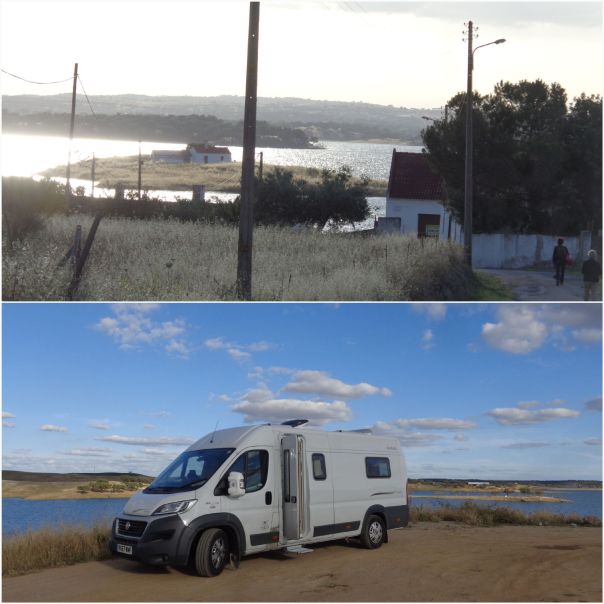
Monday 4th. We moved onto Evora, where we parked beside the impressive aquaduct and went to explore the town. It was cold and wet, and we dressed accordingly only to be too warm when the sun shone in the afternoon. We saw the Temple of Diana and had a general wander.
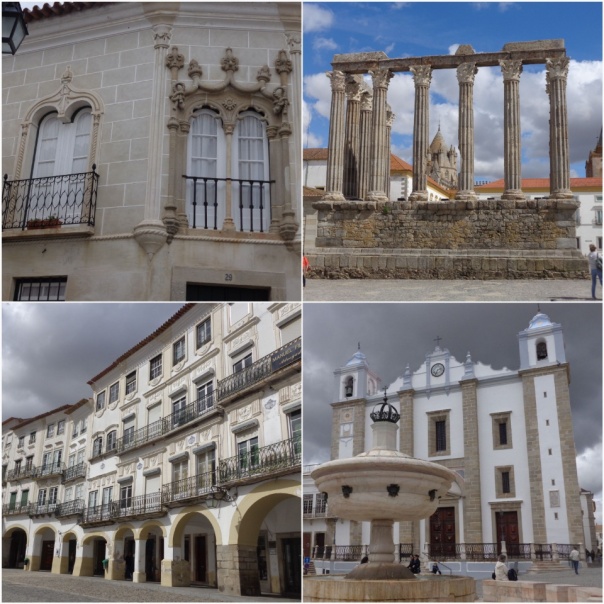

Tuesday 5th. I spent a happy morning sketching round the town. I drew in the Praca de Giraido, and watched while a new street cleaner was demonstrated. You know how difficult it is to chose a new hoover, then realised that it would put all those industruous lady sweepers we saw everywhere out of a job, and no chance of another one with unemployment so high. Which might explain the popularity of the Communist party everywhere.
We are so always impressed with the individual shops in Portugal, always so well presented. And the houses so tiny, some seemed no wider than the front door, almost like the micro houses advertised in London.

I met Andy for lunch and we had a wander down to the Jardin Public, which ran along the old walls, then went back to the Igreja de Sao Joao, 1711, which is famous for its tiles. I had a pleasant time trying to sketch, good to be out the cold wind.

The Museum de Evora had some collected doorways and windows very cleverly set within the fabric of the building, as well as other interesting marble.
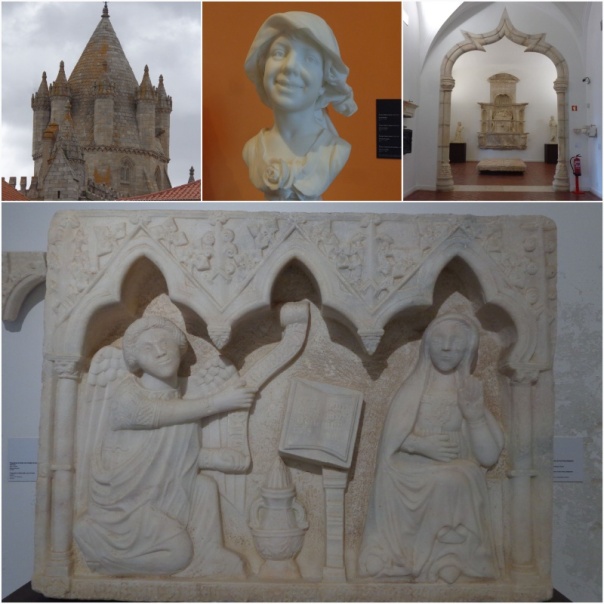
We moved onto the aire at Terrugem for the night, a pleasant quiet spot near the bull ring. Apparently killing the bull became illegal in Portugal in the 1920s, little sign of bull rings in use.
Wednesday 6th. Getting increasingly fed up with the weather. We drove up to an old favourite, Marvao, which is set 850m above the surrounding countryside overlooking Spain. I spent a very happy afternoon sitting in the garden below the castle sketching. The aire has a wonderful position below the town, with a walk up the old roadway, and through a stagggered gateway. The walls run all the way around the town and the walk around the castle walls rather perilous!



Thursday 7th. We moved on to the nearby town of Castillo de Vide, a charming larger town, with a Jewish quarter below the castle walls with the steepest streets I have ever seen, and a medieval settlement within the castle walls. I settled to draw the Fonte da Vila, until it came on to rain, the weather seemed to be getting worse and worse.

I visited the tiny synagogue which has been restored, and once again wished I could read Portuguese. The weather got worse as the evening wore on, we had the heating on to have a shower. Consulting the forecast rain was predicated for our destinations for the next 4 days. Such a shame to miss Batalha, Tomar and Coimbra but this was getting so depressing. Grey skies for as long as I can remember.
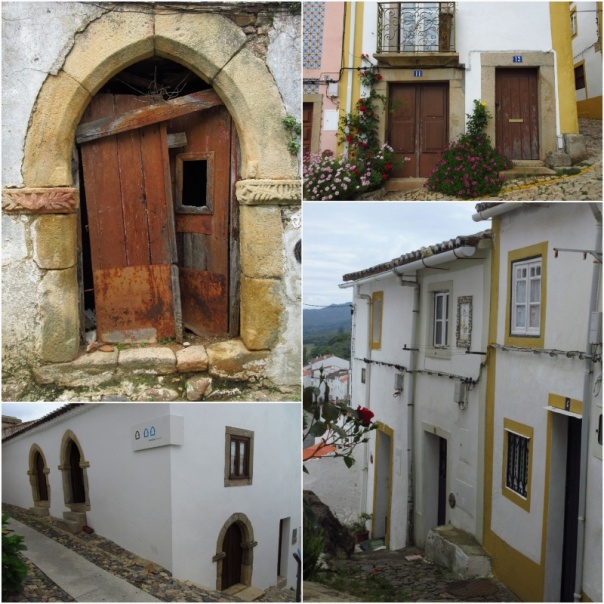
Friday 8th. The van was rocked by rain and strong winds during the night. We visited the local market before a shop up at Pingo Doce. Then we set off to see the local Menhirs and Dolmans on a scenic drive below the town, through fields of purple flowers and scattered cork oaks. I realise the spring flowers would not have survived this long in normal temperatures. We easily found 7m high Menhir de Meada, surrounded by wild flowers and glimpsed other antiquities as well as a pleasant aire beside the reservoir, before the rain set in again…….and we headed for Spain.

Once we arrived at Marida we had travelled 60 miles and the temperature had risen 8′! We wandered round, last visited 20 years ago but could not remember anything. We visited the Roman Theatre and Anfitheatre, impressive what remains then wandered down to the Roman Bridge, remarkable for being the longest built at 800m. We were very surprised to see lots of Roman soldiers marching towards us and watched them assemble and then march through the town!

Saturday 9th. I went into town, having a Roman festival, and settled to watch a ballet rehearsal in front of the Temple of Diana. Then wandered down to the large and mostly empty Alcazaba, where there was a Roman legionaries encampment, and I met Alan, English and now living in Spain who explained to me about his legion, Republican and BC 250. Although volunteers they were paid some expenses by the local government. He said that his legion was really depleted as everyone had to work on their vineyards and olive groves, that they had been unable to get onto during the awful spring.

Andy joined me for lunch, and we sst on a balcony overlooking the Temple of Diana area, we were amazed how many local people had dressed up in costume, right down to tiny babies in togas and even a decorated pram! Everywhere we looked so many people were in costume. We went back in the evening when there was a parade of citizens through the town .

Sunday 10th. We set off for Trujillo, another grey day but promised spring on Monday and Tuesday and summer starting with avengance on Wednesday, with 30′, which will be a shock to all. We found people having their Sunday lunch outside but with patio heaters, we could feel the heat as we walked past. We had parked beside the unused bull ring, and saw some small children acting out a fight in the impressive square. Little brother was the bull.
The impressive square had a statue of Francesco Pizarro, it started off as a statue of Cortes but when Mexico didn’t want it, it was renamed as Pizarro and given to Trujillo. There were a handsome crop of churches and mansions up the hill by the enormous castle, but the glory of the town was the central square, dominated by so many conquistador mansions, and built with their ill gotten gains. The most impressive belonged to Pizarro family and bore a grand coat of arms which included his ships but sadly the building looked about to collapse. So many stork families on so many church towers.
During the evening I managed to wipe all 10 days of diary and had to rewrite. There was also a deafening noise from some considerable distance away, a fair, and the dustbin men came at 23.40!
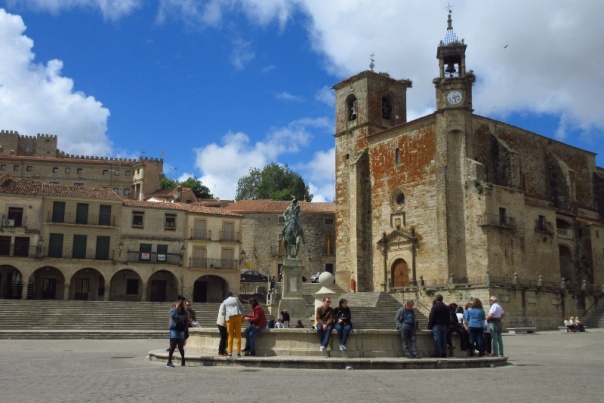

Monday 11th. Promised spring today but looks like it’s been postponed yet again, and grey once more! I read that the good weather in UK will continue all summer, after a blip as we get home, I’ll believe that when I see it! 16′ as I settled to sketch in the square at 11. Spring might be arriving this evening! Patio heaters still burning at lunchtime!
Monday 11th June. I spent quite a bit of the day in the Plaza Mayor happily sketching, where I could hear the storks clicking their beaks in their nests above me. As well as a vista I drew the coat of arms on the Palace de Conquista, which included the faces of Pizarro and his South American wife. I was worried by the state of the building, and when later I saw that money was intended to do up the little- used 1848 bull ring, I thought the money could be better used maintaining the square, which is their main tourist destination, and on which the town relies.
After tea I went for a stroll without bags and cameras, and discovered a whole new area within the castle walls, with yet more conquistador mansions. I also popped into the church of St Francis, which had been built on the site of the mosque. As the wind dropped it became noticeably warmer, and the clouds seemed to be moving away at last.
Tuesday 12th. Blue skies at last as we woke up. Drove north through pleasant countryside to reach the Vera mountains, lots of barns built with lots of ventilation, for drying local pimentos. We stopped at Jaranvilla de la Vera, where we met the most helpful tourist information person ever. Manuel was able to explain in detail and draw detailed pictures upside down on the map, and explained about the special style of architecture locally. We went on to see a couple of the villages mentioned, Cuacos de Yusta and Pasoroa with their half timbered houses, though sadly some in a poor state of repair, we could have bought a typical one for 10,000€.
Above Ciscos was the Monastery of Yusta, where Charles 1st Spain and 5th of Austria came after giving his throne to Philip 2nd. His ‘natural’ son, Don John of Austria was bought to live in Yusta to be near his father and there was a very touching 19th painting in the Monastery. The place was interesting because it was so much more comfortable and even cosy compared with Philip’s Escorial palace we visited last time in Spain. The tranquil woodland setting was charming.
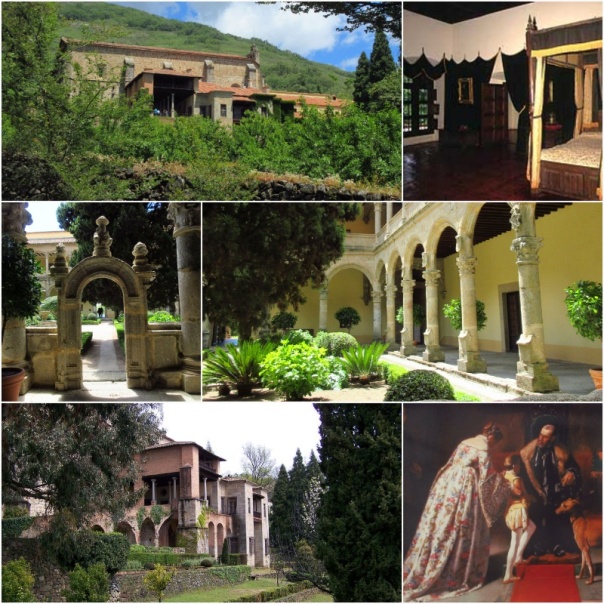
We looked at the door of a church in Cuacos and immediately a gentleman arrived to unlock and give a very detailed tour in Spanish, of which we may have guessed half a dozen words. The barrel roof was of a most unusual lofty brick construction, can’t imagine how it was done. There were also many statues which took part in their Easter parade.
Eventually made it over the hill to the valley of Jerte, famous for its cherries. In the distance the mountaintops still had snow!! The Rio Jerte campsite was unfortunately 80% sad and very tatty statics, which was a shame as the facilities were good. However needed to do the washing and sort a few things.
Wednesday 13th. After jobs, wandered into Navaconcejo where a sizable but usual market was taking place, I then discovered an area of charming half timbered houses, giving a very good idea of what so many places in the Middle Ages must have looked. Why did we chase round after a handful yesterday! Looking onto so many garages and workrooms, cherries being sorted in every one. At last warm and sunny.

Thursday 14th. We drove NE up the Vale de Jerte, passing so many cherry cooperatives and businesses. We stopped to buy a box (now sadly depleted) the ladies were sorting the cherries very thoroughly on a trestle table. Usual price seems to be 5€ for 2kg. We climbed over a pass onto a plateau with very different scenery. Upland pastures and the odd ham processing factory. Then we dropped into the valley, where the scenery started to become boring; and along to Avila.
Avila is notable for the 11th cent. walls which encompass the town, probably the best complete medieval set of fortifications, but look much renovated. The parking spot was conveniently placed, we were unable to find the camp site we stayed in 1998. We remember walking up the hill through gardens and small holdings, and vividly remember a man redirecting a tiny irrigation system. I would guess they are now under the new housing that surrounds the town.
A very likable town, well presented and interesting.

We made our way to the church of St Teresa, a 16th century saint famous for her visions and reorganizing the Carmalites, there was a new statue of St Teresa in front of the church. I had remembered another one from our last visit, so we searched the town, Andy even found a picture of one in Rome he thought I might be thinking of, but eventually we found her just outside the town walls…… and I thought I preferred the new one, more sympathetic. So I came back to the van to collect my chair and went back to draw her.

Later we had an evening walk around the walls, lovely light throughout the city.
Friday, 15th. Easy drive to Segovia, through pleasant undulating scenery that was full of poppies, yellow great mullion and a purple flower I can’t name. There was still snow on the mountains towards Madrid. We easily found the aire and the bus stop for no.5 into town.
The Aquaduct was really magnificent, 894m long and went right up to the walled city where the water supply went underground to reach the Alcazar. Started by the Romans, it was in use till recently.
The town was very pleasant indeed, busy with lots of tourists especially Americans, but not spoilt. The cathedral bordering the Plaza Major was very elaborate. There were also decorated buildings, very like pargitting in East Anglia; also noticed over pointing between the stones, which we know from round Shaftesbury leads to deterioration, as we could see at the castle.

The Alcazar was out on a spur, jutting into pleasant countryside, also with poppies! Looking back at the town we could still see snow on the mountains behind! The castle had been the royal residence in the Middle Ages for the Castilian kings, but had burnt down in 1862, and been reconstructed in a very ‘over the top’ way. It was easy to see why it had inspired Disney! Note storks beside memorial.

Easily caught the bus back to the aire, and returned in the evening when Spain was playing Portugal in the world cup. Not in the slightest interested in football, but wanted to support the underdog! We could hear lots of shouts and cheers as we walked around, and the town went very quiet after the score was equalised in the dying minutes of the game. Unfortunately the quiet did not last once we went to bed, there seemed to be a local race track for motorbikes locally, someone started to play football after midnight and the bins were emptied at 3am on the dot!
Saturday 16th. Drove North to Valladolid, where we attempted to park to do some shopping, we could see the supermarket car park with plenty of room but unable to get there due to height barriers! Eventually parked in nearby street where we were fortunately able to take the trolley. Then drove NE through yet more wild flowers, again poppies and great mullion. We agreed we had never seen so many wild flowers as this holiday, nor birds of prey. We could see quite a bit of snow on the Picos Mountains.

We easily found the Camino de Santiago campsite on the edge of the village of Castrojeriz, a small family campsite with many regular customers. The site also has a hostel for pilgrims, the Camino does seem to be the village’s raison d’etre. Above us on the hill was a templar castle. We ate in the popular campsite restaurant, food rather average but great atmosphere. The owner showed us that had had been listed in the Guardian as being amongst the 20 best camping sites in Europe!
Sunday. Andy had a lazy day round the site whilst I went off drawing just outside the site and in the adjacent village. I seemed to turn into a tourist information service and was able to direct several people, everyone assumed I was local. One lady said to her friend that now she had a chance to try her Spanish, as she turned towards me I said “Not with me.” As I carried my small rucksack through the village, several people passed me and said “Buen Camino”, I felt a fraud!
I learnt that the Templar castle above the village had been started by the Romans, rebuilt from the 700’s onwards and largely destroyed in the Lisbon earthquake. The flowers during the evening stroll out beyond the village were lovely, I don’t remember seeing wild cornflowers before. I could see in the low light that all the hills were extensively terraced.

Monday 18th. Up in time to have good walk through the long village, and out the other side to see the long parade of pilgrims climbing up the hill beyond, looking rather like a hill on the South Downs! I was very worried about one pilgrim, by herself, and very overloaded, she was staggering and weaving from side to side, and taking many more steps than necessary.
When I got back to the van I found that the sailing had been delayed by 3.5 hours, so I was able to continue my walk, popping into the nearby church of My lady of the Apple Tree, most unusual with two main high altars, and naves at right angles. Then walked along the Camino for some distance once again admiring flowers. And pilgrim watching.

Then set off for easy drive to Santandar, and a wait on the dockside where we chatted to a fellow Vantage van owner.
Tuesday 18th. Calm channel thank goodness; most amusingly, Bobby crossed channel the same time as us, we waved to Charlotte in Jersey, who crossed on Sunday!

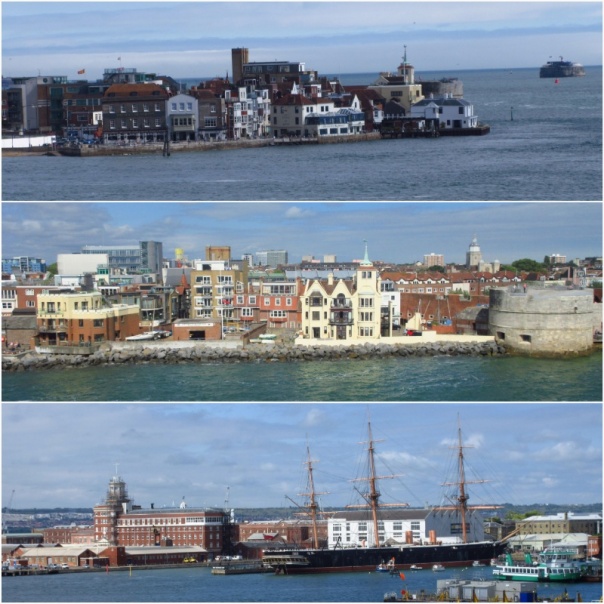
Back home safely, somewhat shocked by the rushhour traffic.
Thoughts about holiday:
- Predominant memories, wild flowers, especially poppies, storks and birds of prey.
- We are not generally fans of Spanish and Portuguese food, eating out ( but must try more pousadas). Ice cream not special. Excellent fresh fruit and salad ingredients.
- Tapas varied widely, poor in tourist destinations.
- Kindness and courtesy everywhere. Children always well behaved. Even babies will sit for hours while parents chat in cafes.
- Prefer wild west coast of Portugal, and generally inland, than the desert like region of the far South of Spain.
- No need to use expensive motorways in Portugal if just wandering like us. Roads in Spain fantastic.

